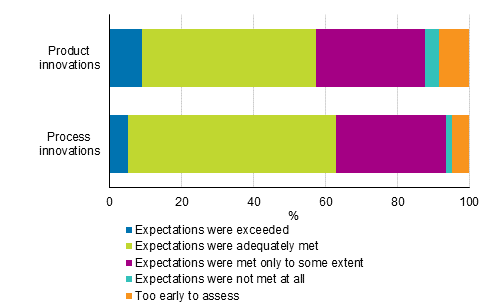6. Innovations related to business processes aim at developing production methods, methods for information technology and data processing and work responsibility and decision making
Nearly one-half of the surveyed enterprises had introduced new or improved process innovations related to different sections of the enterprise’s business activity in 2016 to 2018. The introduction of process innovations was just slightly more common in manufacturing than in services.
Process innovations were more commonly directed to the methods for information and communication technology or data processing, or organising work responsibility, decision making or human resource management and production and methods for producing and developing goods and services. Process innovations were directed to different business processes similarly in manufacturing and services except for renewal of production methods, which was more common in manufacturing than in services.
Figure 5. Prevalence of process innovations implemented by enterprises in total industry and services in 2016 to 2018, share of enterprises

Development of production methods was reported most often in the manufacture of computers, electronic and optical products, which enterprises also reported quite generally other kinds of process innovations. Of the biggest fields by the number of enterprises, nearly every fourth enterprise in the manufacture of metal products (C25) had implemented new or improved production methods, every tenth had renewed logistics, delivery and distribution methods and around every fifth had introduced methods for information processing and communication or data processing that differed significantly from the methods previously used by the enterprise. In wholesale trade (G46) every fourth enterprise had developed logistics, delivery and distribution methods and at least equally many reported innovations directed to methods for information processing and communication or data processing and to organising work responsibility, decision making or human resource management.
As the introduction of product innovations to the market, the introduction of process innovations is also more common in large enterprises than in small ones. Process development is clearly more common than product development work in the smallest size category of the survey, enterprises employing 10 to 49 persons, and in medium-size service enterprises employing 50 to 249 persons.
Two-thirds of enterprises having implemented process innovations had developed new or improved processes in-house by the enterprise. Good one-half of innovators had developed the enterprise’s business processes together with other enterprises or organisations. One fifth had innovated processes by adapting or modifying processes originally developed by others and nearly one fifth had introduced new or improved processes that were developed by other enterprises or organisations.
The majority of those having renewed their business processes in 2016 to 2018 considered expectations related to innovation had been met at least to some extent. Five per cent of innovators thought expectations had been exceeded, and 58 per cent assessed they had been met. Nearly one third, 31 per cent thought expectations had been met to some extent. A few per cent assessed that expectations set for the innovations had not been met, and five per cent felt that it was too early to assess the success of innovations and meeting expectations in the implementation stage of the research.
In practice, over one-half of those reporting product or process innovations thus felt that expectations related to innovations had been met during the survey period. Nearly one third considered the expectations had been met to some extent by the end of the survey period, and a few per cent assessed that expectations had not been met. The effects of innovations may often be realised only after a long time and particularly innovations introduced towards the end of the survey period have perhaps not had time to turn into results, so in all respects the effects of innovations cannot yet be assessed during the survey period.
Figure 6. Realisation of expectations connected to product and process innovations introduced in 2016 to 2018 by the end of 2018, shares of those having introduced innovations

Further information about process innovations by industry and size category
Enterprises’ innovation activity by industry group and enterprise size categoryEnterprises’ innovation activity by industry
Source: Innovation 2018, Statistics Finland
Inquiries: Mervi Niemi 029 551 3263, Heidi Pirkola 029 551 3246, tiede.teknologia@stat.fi
Director in charge: Mari Yl�-Jarkko
Updated 23.4.2020
Official Statistics of Finland (OSF):
Innovation [e-publication].
ISSN=1797-4399. 2018,
6. Innovations related to business processes aim at developing production methods, methods for information technology and data processing and work responsibility and decision making
. Helsinki: Statistics Finland [referred: 19.4.2025].
Access method: http://stat.fi/til/inn/2018/inn_2018_2020-04-23_kat_008_en.html

